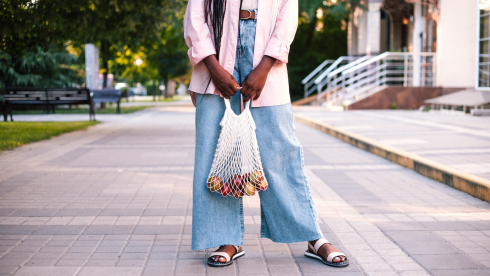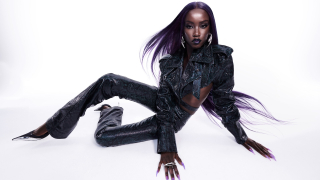The stark bare corners and tables in small rooms represented in a few of Jacob Lawrence’s paintings indicate a time when money and food were scarce and people were on the move. The pale brown tones, the details of the wooden walls, floors and table read cool, thorny and empty, if not destitute. Excerpts from some of Lawrence’s text read: “living conditions were better in the North” or “housing for Negroes was a very difficult problem.”
These images are juxtaposed with images of people traveling in small groups, tightly packed or at least in close proximity to one another, sometimes standing near railroad tracks. The colors are dark and rich; black, deep browns and blues, with spots of red and orange. Warm, which could be interpreted as togetherness and hope. For one painting, the text reads: “And the migrants kept coming.”
These descriptions of paintings and text come from Jacob Lawrence’s Migration Series. The Migration Series and his ability to paint full-time as a part of the Works Progress Administration (WPA) propelled Lawrence into the universe, positioning him as one of America’s great historical painters.
These works and more are currently on view at the Museum of Modern Art (MoMA) as a part of the exhibition One-Way Ticket: Jacob Lawrence’s Migration Series and other Visions of the Great Movement North, masterfully curated by Leah Dickerman.
“Jacob Lawrence was one of our great storytellers,” states Schomburg Center director Khalil Gibran Muhammad. “He was absolutely one of the first to make history through painting.” More than an exhibition of an “old master,” the MoMA exhibit is an experience in history that takes viewers back in time, placing Lawrence at the center as artist and researcher in collaboration with many artists, writers and educators—including Ella Baker, one of a handful who would go on to become major civil rights leaders.
Leah Dickerman wanted to infuse contemporary voices of poets in response to Lawrence’s work. She tapped Pulitzer-winning poet Elizabeth Alexander, who came with the idea to commission 10 of the “greatest living writers” and have them respond to Lawrence’s work. This was born of what Alexander understands as a writer, and that is, “culture does give birth to culture, that’s how it works.”
MoMA and the Phillips Collection organized the exhibition in collaboration with Harlem’s Schomburg Center for Research in Black Culture. “Leah reached out to me with the goal of putting together a curatorial advisory committee representing writers, thinkers, filmmakers and historians,” says Khalil Muhammad. The idea was “that they would construct the world that Jacob Lawrence came of age in,” he continues.
With everyone on board, Dickerman continued to push her vision of making sure this exhibition not only reunited Lawrence’s 60 Migrations Series panels (split evenly between the Phillips Collection and MoMA) but also demonstrate how Lawrence is thinking about “narrative strategies and how to tell history through art.”
The exhibition gallery spaces are a combination of painting and multimedia; there are poems on walls and poems being performed. There are also works by Lawrence’s contemporaries—Charles White, William H. Johnson and others—who captured life of Black migrants, such as photographer Dorothea Lange. One gallery not to be missed is the Artist as Historian. This is a room that encompasses Lawrence’s time at the then 135th Street library (now, the Schomburg Center).
“Hopefully this [collaborative exhibition] will be a model for taking seriously that Black history matters, that Black art matters, that Black people not only tell stories of this country but also created and shaped it,” said Muhammad.
The programming for the exhibition is explosive. With poetry readings, live music, film screenings and a performance piece by Brooklyn-based artist Steffani Jemison, the exhibition has positioned itself to be one of the most transformative institutional and artistic collaborations of 2015.
To provide greater context for the work of Jacob Lawrence and the contemporary significance of this exhibition, EBONY.com caught up with curator Leah Dickerson to discuss her insights on this profound historical exhibition.
EBONY: Talk about what you wanted to achieve by including works by writers and other artists.
Leah Dickerman: I think it’s a myth in our society that genius is isolated. To better understand how these great, paradigm-shifting ideas play out and trace the trajectory of thought is what I like to do in an exhibition. Lawrence was the first Black artist to be represented by a New York gallery. He was the first Black artist to be purchased by MoMA. These are groundbreaking events and I think he was actually ambivalent about that early fame.
He felt that he had made art in relationship to the community in which he’d been nurtured, in relationship to these conversations he’d been having as a young artist, and something about that fame pulled him out of these conversations. If you read his recollections and his oral histories and his interviews, he’s always saying, “I did it because of the community.” So I thought, okay, let’s see what happens if you put him back into the conversation with the community.
EBONY: Jacob Lawrence did much of his research at what was then the 135th Street library. Could you share a bit about how you decided to work with the Schomburg Center for this exhibition and why that was important?
LD: I thought that it was a very powerful idea. Lawrence was an artist that benefited from the Works Progress Administration, the WPA program, during the New Deal cultural programs during the depression. That money allowed for a huge range of courses and program and Black-artists-run workshops. And that was groundbreaking, because for many White artists, the WPA replaced money that they might have had previously. But for many Black artists, it was money that hadn’t existed previously and allowed many to work in their discipline full time for the first time. So there was kind of a second flourishing of Harlem culture.
Lawrence’s series tells you that history matters, and that is in many ways the over-arching message. We know that Aurturo Schomburg built this great collection of books and prints and other media that was designed to present evidence of Black historical accomplishment. And those were the books that Lawrence read and studied before he started painting.
We also know that he went to history clubs at the [YMCA], and there were history clubs at the at the 135th Street branch library—which was run by Ernestine Rose, the librarian—and it was also run by Ella Baker. And Ella Baker, as you know, would become one of the great leaders of the civil rights movement two decades later. I get interested in the idea that so many of the players in Lawrence’s world are also people that reemerged two decades later as leaders of the civil rights movement.
One-Way Ticket: Jacob Lawrence’s Migration Series and other Visions of the Great Movement North opens to the public today, and will be on view through September 7, 2015. For more information and for a full list of events visit the MoMA website.
Una-Kariim A. Cross is a writer and educator focused on strategic arts and technology partnerships and programs in education for urban youth.













